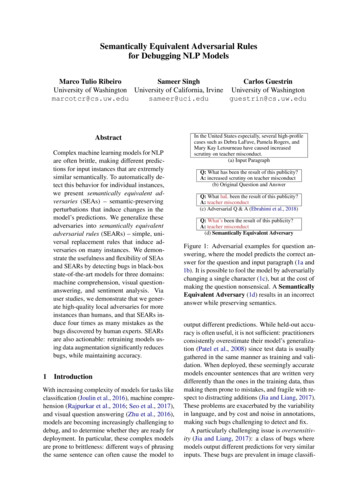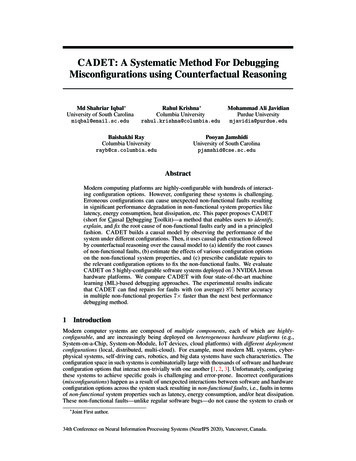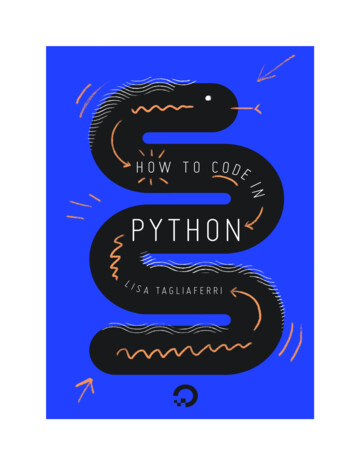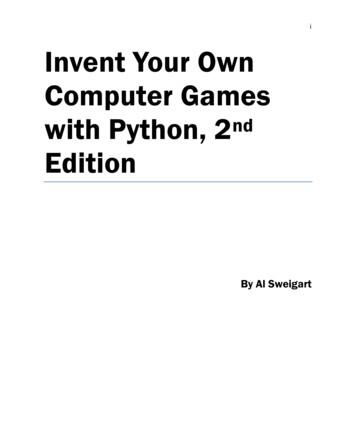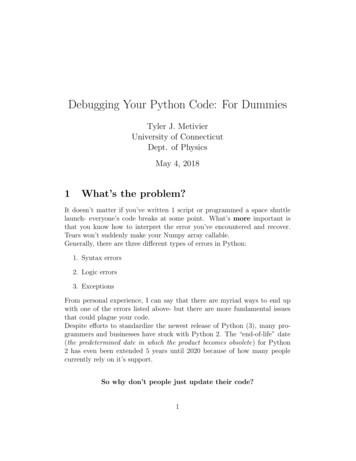
Transcription
Debugging Your Python Code: For DummiesTyler J. MetivierUniversity of ConnecticutDept. of PhysicsMay 4, 20181What’s the problem?It doesn’t matter if you’ve written 1 script or programmed a space shuttlelaunch- everyone’s code breaks at some point. What’s more important isthat you know how to interpret the error you’ve encountered and recover.Tears won’t suddenly make your Numpy array callable.Generally, there are three different types of errors in Python:1. Syntax errors2. Logic errors3. ExceptionsFrom personal experience, I can say that there are myriad ways to end upwith one of the errors listed above- but there are more fundamental issuesthat could plague your code.Despite efforts to standardize the newest release of Python (3), many programmers and businesses have stuck with Python 2. The “end-of-life” date(the predetermined date in which the product becomes obsolete) for Python2 has even been extended 5 years until 2020 because of how many peoplecurrently rely on it’s support.So why don’t people just update their code?1
Python 2 and Python 3 are incredibly similar, but there are some largedifferences in how they accomplish tasks. Python 2 contains many built-infunctions and dependencies that simply don’t exist in Python 3. This canbe a major problem if you want to work in Python 3 but your code is basedon a function that doesn’t exist anymore.So what if you run into this issue? Perhaps you were browsing Github anddownloaded some interesting-looking code to you. You try to run it and.The terminal returns to us: the file name, the line that triggered theerror, and the type of error, respectively.So we see that our file contains a syntax error in line 4 (more on syntax errorsin section 2). By inspection, we can see that the line, print“test”, does NOThave parentheses around the argument: print(“test”). We received this errorbecause we tried running a code written in Python 2 on our system runningPython 31 . The line above is completely valid in earlier releases of Python,but now it isn’t. This is one example of how Python 3 requires more ”order”than its predecessors. Indentation and syntax matter in the long run whencodes become complicated. Luckily, Python 3 comes with a very helpfulscript that you can call in any directory: 2to3.Now I could open my code and go through adding () after every “print” I see,but what if there are thousands of lines or more errors hiding? Accomplishingtasks systematically is generally much better practice than doing it manually.Looking at our original problem:We see the missing parentheses on line 4, just like we saw before. Now wecan enter the following into the terminal (the file here is called test.py):1To find out which version of Python you have, type: “python -v” into the terminaland it will return the installation directory and version.2
Python’s 2to3 script usessomething called a “fixer”to interpret code, identifywhat’s outdated, and changeit into working code. Fixers work by reading throughcode and identifying Python2-specific blocks of text.When a piece of outdatedcode is recognized, 2to3 willscan through its database toidentify what the Python 3equivalent is. Simply running this program (as shownabove) will rewrite your original file with the implemented fixes. However, 2to3 always saves a backup2 .If we run the same line again but with a -w after 2to3, this will restore thesource file to its original form.As seen to the right, 2to3 subtracted the line that was causing trouble andthen put it back with parentheses. This can be a big time-saver dependingon what you’re working with.Now if we reopen the file, we see thatparentheses have indeed been added.But of course, most errors aren’t because ofconversion issues. The generalized type oferror we saw here was a syntax error. Syntax errors are ”fatal”- meaningthat when one is encountered, the code will fail to execute and the script willstop being read at that line.Above, we were kicked out of the code at line 4 when Python didn’t understand the print argument. When Python encounters a line of code it can’tread, it is a syntax error. Above is an example of an incorrect argument. Syntax errors are also commonly due to typos or incorrect indentation (mixeduse of spaces and tabs).2Adding a -n to your original call will generate no backup file- this is NOT recommended.3
A more complicated situation is the logic error. Logic errors could crashyour code or seemingly do nothing at all. They often go completely undiscovered because your code may appear to run perfectly fine. However, thatdoesn’t mean that it’s running correctly. Even though your code may appearto be fine, you may have used the wrong variable name in a function andyour mathematical result is 5 orders of magnitude different than expected.Lastly, we have the exceptions. This occurs when Python correctly interprets the code you wrote, attempts to execute it, and for whatever reasoncannot. For example, if my code relied on a web-based repository and Iattempt to run it while on vacation at the Hubble Space Telescope- it maythrow an exception due to me not having the HST wifi-password (becauseI’m in space. get it?). Python knows what I want to do, it just can’t do itbecause there’s no internet connection.2How do I fix it?After identifying the type of error, we can begin to try and figure out howto solve the problem.Dealing with syntax errors is generally not a very difficult task. Becausethey are mostly comprised of typos, inconsistent indentation, and incorrectusage of arguments- we can start fixing the problem when we know where itis. Just like when we found the syntax error before, the terminal tells us thefile that caused it and the exact place where the code breaks down.If the problem seems clear to you (made a typo, forgot parentheses, etc.)simply attempt to implement the fix and rerun your code. If you can’t identify the issue, try browsing a website like StackExchange to see if other peoplehave encountered the same problem3 .Learning Python means learning how other people code and deal with theirproblems, as people often find ”better” and easier ways to accomplish suchthings.The most frustrating part about logical errors is that they are occasionallyinvisible. If you’ve encountered a logic error, the first thing you can do islook over your code entirely. The issue may be easy to identify- you may3Link: https://stackoverflow.com/questions/tagged/python4
have meant “x1” and accidentally put “x!”. Or your code may be comprisedof many convoluted mathematical functions that would take an incredibleamount of time to pour through.If you really want to rid your work of logic errors- the recommended courseof action is to install a debugging software. Python comes with a debuggingmodule “pdb” installed, so this would be the best one to try initially.We can debug a code of our choice with the terminal entry above. (Hopefully) the debugger will identify issues in your code and implement fixes.If all else fails, you can go line by line and try to make sense of what couldbe going wrong. Python will do exactly what you tell it to do- as long asyou know what you’re actually telling it to do. This is why debuggers canbe helpful when the source of the error is unknown. In a similar fashion to2to3, debugging software looks for identifiable pieces of code and attemptsto implement corrections. Naturally, this method is not always perfect.In science, being mindful of your expected results is vital. If you run yourprogram and receive a value, take time to consider if it’s reasonable or makessense given the situation. If you are expecting to receive a histogram withan exponential trend but instead receive:-you may initially want to run your fancy debugging software to fix the issue. But that won’t help you whatsoever in this case. Nothing is actuallywrong with your code. Instead, if we look at the generated plot and notice5
that something’s funky about the scale on the vertical axis- we are halfwaythrough solving our problem.We may discover that a lonesome “log True” was the culprit all along. Removing that argument then generates:We now have our expected exponential trend. But still there was nothingever wrong with the code- we were just accidentally telling it to do somethingand it listened.Exceptions are the least frightening to deal with, as this means that yourcode is (probably) not broken. You are requesting something from Pythonand it understands your request- it just can’t help you. That means it’s allon you here. Once again, we must look and see where the terminal is tellingus the error is. Once we’ve found the location, we can implement fixes.If we find the exception is thrown because there isn’t internet and we’re asking Python to go to a website- we either need to get a connection or workaround the issue.Creating an “exception handling block” can allow us to bypass exceptionrelated errors. This is most commonly done with a “try-except block.” Anexample of a try-except block is:6
Under both try and except, we see we are ultimate attempting to call a textfile and call it “catalog.” We first try to simply call the file from our system.If the file exists within your working directory, the catalog should be readwith no problem. If this file doesn’t exist, we attempt to call the file in analternative method with except.As shown above, we first attempt to download the text file with os.system(.).Here, we are telling our computer to “wget”4 (install from the internet) ourfile from a web page, “dl base.” In this specific situation, we can definedl base as some url to the website we want to get our file from. There is also“/files/directory catalog 135.txt” appended at the end of the line. This justspecifies the exact file that we want to download from this website.If your computer doesn’t have the file AND doesn’t have internet. it maybe time to call a local internet service provider.Despite the fact that Python errors come in many different forms, it’s goodto have a methodology when working through them.1. Read your code thoroughly before attempting to run it.2. Identify the type of error you may be receiving.3. Based on the type of error, use the provided suggestions or researchhow to bypass your issues.4. Never be afraid to use the internet as a guide- chances are that someonein the world has already encountered the issue you’re facing.4Wget is a very common program that allows you to download content from the internetthrough the terminal/command line. (https://www.gnu.org/software/wget/)7
Python 2 and Python 3 are incredibly similar, but there are some large di erences in how they accomplish tasks. Python 2 contains many built-in functions and dependencies that simply don’t exist in Python 3. This can be a major problem if you want to work in Python 3 but you

